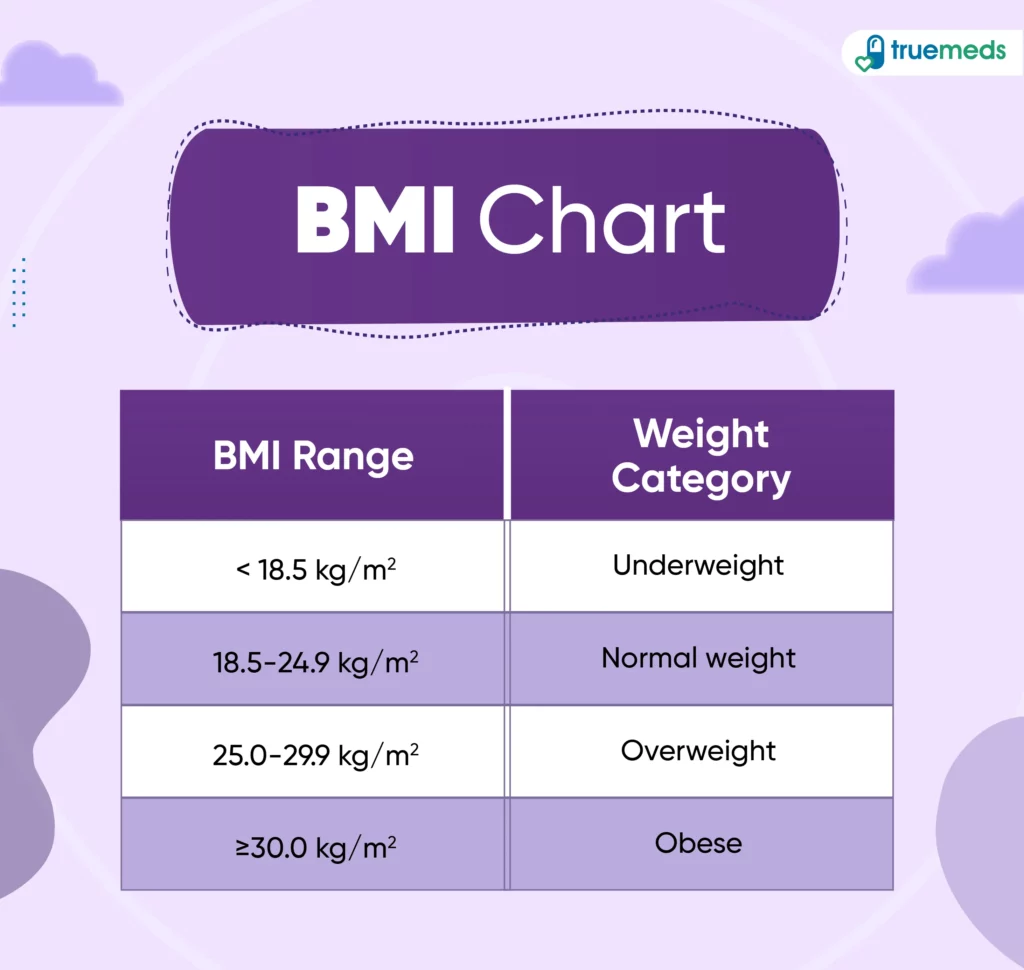BMI Chart for Men and Women: Learn How to Calculate BMI
Last updated on : 25 Mar, 2025
Read time : 11 min
Body Mass Index (BMI) is a commonly used tool by healthcare professionals to estimate body fat levels based on an individual’s height and weight measurements. It serves as a quick screening method to assess potential health risks related to weight, such as obesity, heart disease, and diabetes. However, BMI does not directly measure body fat percentage and may not always provide an accurate representation, especially for athletes, older adults, or individuals with higher muscle mass, as it does not differentiate between fat and muscle weight.
What is Body Mass Index (BMI) and Its Use?
BMI, or Body Mass Index, is a measure that assesses body fat based on weight and height. It is a quick and easy way to identify if a person is underweight, normal weight, overweight, or obese. Calculating BMI helps in understanding potential health risks associated with weight. If BMI is too low, it may indicate malnutrition or certain health issues. If it’s too high, there’s an increased risk of conditions like diabetes, heart disease, and joint issues. Monitoring BMI is crucial for maintaining overall health, as it assists you and doctors in making informed decisions about diet, exercise, and lifestyle to achieve and sustain a healthy weight. If you are concerned about your health and weight, it’s better to calculate your BMI. Regular BMI assessments can help in the early detection of weight-related issues. Let’s explore what is BMI Chart, for what it is used for, and its range, health risks associated with increased BMI, its limitations, and how to calculate it.
BMI Chart for Men and Women
To determine your BMI weight category, consult the BMI chart. There you will find your height and then move across the row until you find your weight. Then, move up the table to locate your BMI and weight category.
BMI chart is same for both genders. It remains the same for adult men and women. It is different for children and teens. The standard weight status categories based on BMI are as follows:

The BMI range classifies your body into underweight, normal weight, overweight, or obese. A BMI below 18.5 kg/m2 indicates underweight, possibly due to inadequate nutrient absorption or insufficient calorie intake. Underweight individuals are susceptible to the following health conditions:
- Osteoporosis (bone loss)
- Anemia
- Premature births
- Fatigue
- Immune disorders (getting sick frequently)
- Infertility issues
So, if your BMI falls in this category, it’s recommended that you consult with a doctor. They can guide proper nutrition, supplements, appetite syrups and strategies to increase your daily calorie intake. It will address your underweight condition and associated health risks.
If your BMI is in the range of 25.0-29.9 kg/m², it’s crucial to be attentive as you are categorised as overweight. You might be at elevated risk of developing the following conditions:
- Heart problems
- Hypertension
- Diabetes
- Liver problems
- Arthritis
- Early age cancers
If your BMI is in this range, engaging in physical activity, burning excess calories, and adopting a weight management diet to reduce the risk of developing health conditions is advisable.
An individual having a BMI of 30.0 kg/m² or above is considered obese. Obesity can be due to unhealthy eating patterns, excessive calorie intake, and low levels of physical activity. In some cases, certain medications or genetic history can also bring out obesity. There are further 3 levels in which obesity can be categorised:
| Obesity levels | BMI Range |
| Class I | 30.0 – 34.99 kg/m2 |
| Class II | 35.0- 39.99 kg/m2 |
| Class III (Severe obesity) | ≤ 40 kg/m2 |
BMI Categories for Women
The BMI chart serves as a general guide for assessing body composition and health in women. Although BMI ranges are similar for both genders, women naturally have a higher percentage of body fat than men, influencing how BMI is interpreted. However, BMI does not distinguish between fat and muscle, meaning a highly muscular woman could have a high BMI without being overweight. While useful for evaluating health risks, BMI should be considered alongside other measurements for a more accurate assessment of body composition.
BMI Categories for Men
For men, BMI is commonly used to determine weight status, though its interpretation varies due to physiological differences. Men typically have greater muscle mass than women, which can impact BMI readings. Since BMI does not differentiate between fat and muscle, a muscular man may have a high BMI while maintaining a healthy body fat percentage. Although BMI is a useful screening tool, it should be complemented with other health assessments to provide a more accurate evaluation of overall fitness and well-being.
What is the Normal BMI Range?
The normal Body Mass Index (BMI) range is typically between 18.5 and 24.9. Normal BMI for men is same as for women. If your BMI is within this range, you’re in a healthy zone. It’s advisable to maintain this range and consider a weight management diet only if there’s a risk of going beyond it.
To maintain a normal BMI, focus on a balanced diet. Include plenty of vegetables, fruits, lean proteins, and whole grains. Limit intake of artificial sugars, sugary snacks and beverages, as well as processed foods. Keep yourself hydrated throughout the day.
Incorporate regular physical activity into your routine. Aim for at least 150 minutes of moderate-intensity or 75 minutes of vigorous weekly exercise. This could include walking, jogging, zumba, cycling, swimming or dancing.
Also, pay attention to your body’s hunger and fullness cues. Maintain a calorie deficit (balance the number of calories you Developing healthy eating and exercise habits) can contribute to maintaining a normal BMI and overall well-being.
Health Risks Associated with Increased BMI
Increased BMI is a risk factor for many other health issues. These may include:
- Heart problems: A high BMI increases the risk of heart disease, including heart attack, heart failure, and other evere heart disease.
- Dyslipidemia: Increased BMI is linked to abnormal levels of cholesterol and fats in the blood, contributing to atherosclerosis and an increased risk of cardiovascular events.
- Psychosocial Impact: Obesity has long-term negative effects on mental health, contributing to depression, anxiety, social isolation, discrimination, lower quality of life, and stigmatization.
- Stroke: Higher BMI is a risk factor for stroke, often due to the association with hypertension and other cardiovascular issues.
- Type 2 diabetes/gestational diabetes: Obesity increases the risk of developing type 2 diabetes. During pregnancy, gestational diabetes becomes more likely in women with elevated BMI, posing risks to both mother and baby.
- Hypertension: Obesity can also make you susceptible to hypertension, increasing the risk of other related complications.
- Sleep apnea: Excess weight can lead to sleep apnea, a serious sleep disorder characterised by breathing difficulties during sleep, contributing to fatigue and increased cardiovascular risk.
- Liver cirrhosis: Non-alcoholic fatty liver disease (NAFLD) and, in severe cases, liver cirrhosis is more common in individuals with obesity.
- Osteoarthritis: Excessive weight exerts additional stress on joints, leading to the degeneration of cartilage and the development of osteoarthritis.
- Gallstones: Obesity increases the risk of gallstones, which can cause pain and other complications in the gallbladder.
- Certain types of cancers: Increased BMI can also increase the risk of cancers, including endometrial, breast, and colon cancers.
- Preeclampsia: High BMI during pregnancy increases the risk of preeclampsia, a condition characterised by high blood pressure and potential organ damage.
- Perinatal and pubertal risks: Pre-pregnancy obesity raises the risk of perinatal death, and recent analysis suggests an increased risk of early pubertal growth in daughters of obese mothers.
- Dental health problems: Obesity is linked to dental issues such as caries (cavities), periodontitis (gum disease), and xerostomia (dry mouth).
How to Calculate BMI?
To calculate BMI (Body Mass Index), divide your weight (kg) by the square of your height in cm. Multiply the result by 10,000 and round to one decimal place.
- [weight (kg) / height (cm) / height (cm)] x 10,000
or
- weight (kg) / [height (m)]2
For example, if you weigh 58 kg and you are 154 cm tall, your BMI is calculated as (58 / (154 X154)) X 10,000, resulting in a BMI of approximately 24.4.
It is a quick way to estimate body fat and assess whether you’re in a healthy weight range, but it doesn’t consider muscle mass or fat distribution. The BMI calculator for women and men and children remains the same.
How do I Calculate my BMI?
You can calculate your BMI manually with the above-mentioned formula or by using an online calculator. Alternatively, there are mobile apps designed explicitly for this purpose. Many health websites, fitness apps, and even some search engines offer BMI calculators. Simply input your weight and height, and the app automatically generates your BMI. Alternatively, some smart scales also provide BMI measurements and other health metrics. These digital methods save you from manual calculations and provide a quick way to assess your body mass index.
What are the Limitations of BMI?
While BMI helps assess body fat based on weight and height. It has certain limitations when assessing an individual’s health.
- Firstly, it doesn’t distinguish between muscle and fat. Those with high muscle mass, such as athletes, may have a higher BMI despite low body fat. Conversely, older adults may have a lower BMI despite having more body fat.
- Secondly, BMI doesn’t account for fat distribution. Someone with excess abdominal fat may face different health risks than a person with fat distributed elsewhere.
- Thirdly, BMI doesn’t consider differences in bone density and other factors affecting weight. They may have a higher BMI.
- Additionally, BMI doesn’t provide precise information on health conditions or overall fitness. It’s a general tool that may misclassify individuals.
- Lastly, BMI doesn’t address variations in age and gender, making it less accurate for certain groups. For instance, older adults may have different health risks at the same BMI as younger individuals.
Takeaway
Body Mass Index (BMI) is a quick measure assessing body fat based on weight and height. An increase in BMI can be indicative of the risk of type 2 diabetes, heart disease, hypertension, certain cancers, and joint problems. It may also indicate the likelihood of developing respiratory issues like sleep apnea. Conversely, a low BMI may suggest malnutrition, weakened immunity, or underlying health problems. Maintaining a BMI within the normal range (18.5-24.9) can help prevent the risk of various health concerns such as heart disease and diabetes. It also aids in the early detection of weight-related issues, guiding informed decisions on diet and exercise for a healthier lifestyle. Monitoring BMI can also help you make proactive choices towards maintaining a healthy weight. You can assess BMI regularly using online calculators or apps or manually with the formula mentioned above. While BMI is an easy measure, it should be used cautiously. Other body assessments or metrics like waist circumference, body fat percentage, and overall health evaluations are necessary to precisely evaluate your health condition.
FAQs
BMI indicates body fat but doesn’t distinguish between fat and muscle. It provides a general measure based on weight and height.
The normal BMI (Body Mass Index) range is typically between 18.5 and 24.9. This range is associated with a healthy weight relative to height.
The normal BMI range for females is the same for males, children or older adults. It is generally between 18.5 and 24.9.
BMI for women is calculated using the same formula as for men or children. To calculate BMI, divide your weight in kg by the square of your height in cm. Multiply the result by 10,000 and round to one decimal place.
Female BMI calculator is as under:
[weight (kg) / height (cm) / height (cm)] x 10,000
or
weight (kg) / [height (m)]2
Disclaimer
Our healthcare experts have carefully reviewed and compiled the information presented here to ensure accuracy and trustworthiness. It is important to note that this information serves as a general overview of the topic and is for informational purposes only. It is not intended to diagnose, prevent, or cure any health problem. This page does not establish a doctor-patient relationship, nor does it replace the advice or consultation of a registered medical practitioner. We recommend seeking guidance from your registered medical practitioner for any questions or concerns regarding your medical condition.
Popular Articles
Recommended Articles
Recent Articles
Top-Selling Medicines:
...View more
Top-Selling OTC:
...View more
Company
About UsHealth ArticleHealth StoriesDiseases & Health ConditionsAll MedicinesAll BrandsNeed HelpFAQSubscribe
Registered Office Address
Grievance Officer
Download Truemeds

Contact Us
Our customer representative team is available 7 days a week from 9 am - 9 pm.
v3.7.10
Our Payment Partners



























































